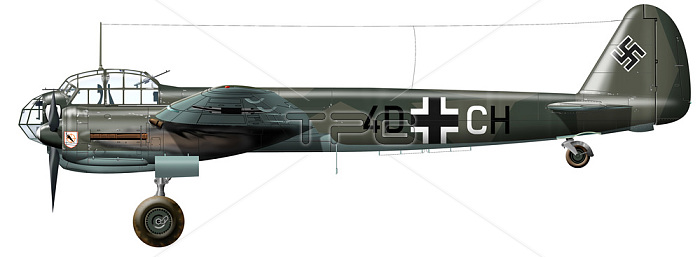
World War II AircraftThe Ju 88 was the most versatile aircraft in the Luftwaffe's armoury; serving as a level and dive-bomber; torpedo-bomber; heavy day- and night-fighter and eventually even as a flying bomb. Over 15;000 of all variants including prototypes were built; and the type served from the first day of the Second World War to the last. The principal bomber variants in 1940 were the A-1 and A-5; the A-4 which entered service in October 1940 becoming the most-produced of all. The A-4 had remedied most of the shortcomings of the earlier models; not least in having an increased wing span and stronger construction to withstand the stresses of the dive-bombing role; and defensive armament was five flexible 7.92 mm machine guns - an improvement; but still not enough to adequately defend it against RAF fighters. Maximum bomb-load was 3;000 kg (6.620 lb) but normal bomb-load was 1;500-2;000 kg (3;310-4;410 lb). Two Jumo 211 J-1 or J-2 engines gave it a top speed of 290 mph and its operational range was 1;100 miles. 4D+CH served with KG30. On 24th July 1941; it made a forced landing at Yaverland; near Sandown on the Isle of Wight. The crew; led by Lt. W Deiderich; were returning from a raid over Birkenhead and had lost their way due to successful jamming of the returning homing beacons by the RAF. They then circled for several hours before putting down in Yaverland; having thought the Solent was the English Channel. On landing and realising their mistake; the crew set the onboard charges and evacuated the aircraft. As they made their way from the aircraft; they instructed locals in English not to go near. Minutes later it exploded and the fire then engulfed the aircraft.Illustration (Tim Brown); 2019.
| px | px | dpi | = | cm | x | cm | = | MB |
Details
Creative#:
TOP28048202
Source:
達志影像
Authorization Type:
RM
Release Information:
須由TPG 完整授權
Model Release:
No
Property Release:
No
Right to Privacy:
No
Same folder images:

 Loading
Loading